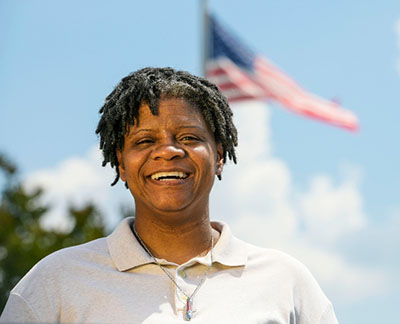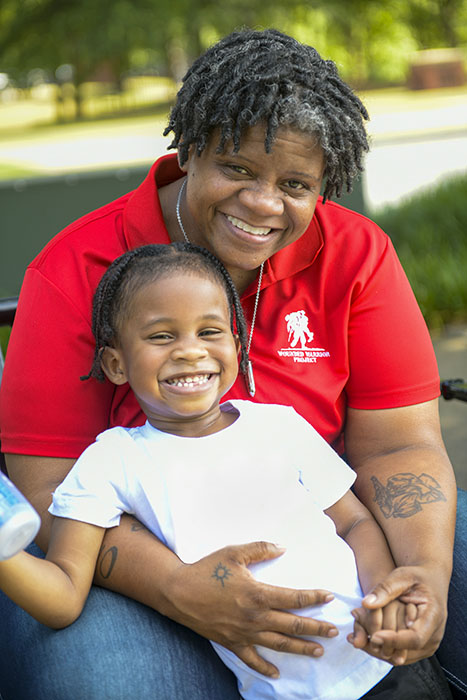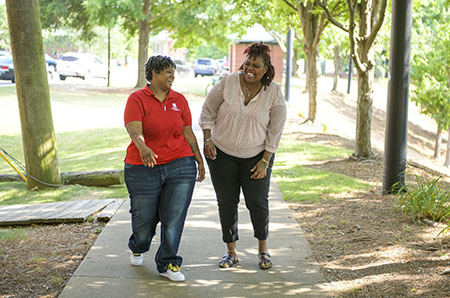Words of a Woman Warrior: Continuing the Journey of Mental Wellness

Air Force veteran Sam Hargrove served her country for more than a decade and experienced a tough transition from the regimented military world to an unfamiliar civilian lifestyle. Women like Sam represent the fastest-growing population in both military service and the veteran community but also face unique challenges as they transition out of the military.
As an African American, lesbian veteran, Sam knew her experiences were even more unique, and her path may be rockier than others. Between stigmas with her identity, to post-traumatic stress disorder (PTSD), and challenges she experienced with anger and alcohol, she felt her next mission in life was impossible to conquer.
Wounded Warrior Project® (WWP) sat down with Sam to learn more about her experiences as a woman warrior, how she overcame challenges with mental health, and what she learned through support from WWP.
Question: Did you notice gender play a role in your time in the military, or in your time after retirement?
| According to WWP’s 2023 Women Warriors Report, women warriors have a higher unemployment rate (10%) than male warriors (6%) despite seeking higher education at higher rates. |
Sam: I felt as if I had to fight harder than my male counterparts to feel included. There’s this stigma that men can do certain jobs better, and in my career field of information technology and system administration, it’s male-dominated. They would send the guys out to do a job before they would send any females.
Unfortunately, my career was cut short when I had to medically retire. But I still work in that male-dominated field. A man with less experience would always get hired before I would – I had more experience and education, but I would see men get hired easily before me.
Question: What was life like when you medically retired? What obstacles did you face and how did you navigate them?

Sam: When I first got out and moved back to Georgia, life was difficult. It was like two weeks of processing and then I was done. That was it. I didn’t have any more structure. I was trying to find a job and figure out how I was going to get my military service to transfer to civilian life. I didn’t have anything to fall back on.
So, I started going to school, trying to finish up my bachelor’s degree but also trying to get a job because the retirement check just wasn’t enough. So, I became a field technician and eventually got a job with the VA, moving me from Georgia to Virginia.
Just trying to reacclimate to being a civilian – not having that structure. It was just so plain and simple. “OK, you’re out now. What are you going to do?”
Question: How has your gender impacted your journey and transition after the military?
Sam: I’ve always been taught to put myself last. Women are naturally nurturing and have that motherly instinct, but we never take care of ourselves first. In my mind, I thought I would just be okay. But in reality, my world was crumbling little by little mentally.
Question: When did you realize that you needed help?
Sam: My godson’s mother and I got into a big argument, and I punched a wall. I didn’t know [my godson] was right there, watching it all unfold. But he was, and I scared him. I was drinking. I was angry. I was upset, and I thought to myself, “I can’t keep doing this to people.” And I really contemplated suicide. So, I went to my VA social worker.
I didn’t want to be that image or that type of model for my godson. I needed him to see something better than that. And I thought to myself that if I take my own life, well, that would hurt him even more.
Question: What has building a support system looked like for you?
Sam: My support system has really grown since I’ve been able to share my story. It took a lot, especially coming from a military background, to tell my family what was going on with me. But, once I was able to say, “Hey, this is my story,” it was like, “Wow, I didn’t know you went through all of that.”
| According to WWP’s 2023 Women Warriors Report, the rates of suicidal ideation (29.1%) and the prevalence of at least one attempted suicide are higher among women warriors (33.2%) than male warriors. Plus, WWP women warriors are more likely to present with moderate to severe symptoms of PTSD (50.7%), depression (58.7%), and anxiety (49.3%) than male warriors. |
So, allowing them to learn more about me made them more understanding, caring, and sensitive to the things I went through. Now, they may understand why I don’t like thunderstorms or why fireworks would shake me up, or why I’d wake up in the middle of the night sweating.
It’s important to have that system – they ground you. And, if you don’t have that to ground you, you go into fight or flight.
Question: When did you realize it was OK to open up to your family and tell them your story?
Sam: Participating in WWP’s Warrior Care Network was the turning point. They say it’s an intensive outpatient program, and they mean that. They put you in situations where you’re uncomfortable, but you’re in a safe environment to learn it all. You have to put yourself in uncomfortable situations to know that you’re safe, and that was the biggest thing. Just to be able to say, “I know this will be uncomfortable to say in front of you, but this is what happened. Please understand this is why I react the way that I do.”
Watch Sam Hargrove discuss her experiences with WWP’s Warrior Care Network
|
According to WWP’s 2023 Women Warriors Report, women warriors report significantly higher levels of loneliness (73%) than males (64.9%). WWP offers women-only connection events and peer support groups that build an inclusive community of healing and empowerment. Women support structures help to restore service and sacrifice connections and strengthen veteran identity. |
Question: This journey of healing is a daily choice and a continuous process. How have your views and actions changed since you first asked for help?
Sam: I talk a lot more now. When I first started, I would just sit there and my counselor would be like, “OK, we can just sit here if you want.” And we did. Eventually, I started talking little by little and now I talk to my counselor about everything: what’s bothering me, everything that makes me happy. Now I just want to tell everybody to go to therapy because it helped. It helps to talk to somebody.
Question: What role has connecting with other women warriors played in your healing?
Sam: The most pivotal thing is just that men are not facing the same thing that women are. So, it becomes challenging to be in a peer support group full of men. You can’t relate. But, as a woman, it’s easier to open up to other women with similar experiences or ways of dealing with things.
Find out how WWP supports women warriors.
Question: There are several stigmas attached to different identities, including race, sexual orientation, gender, or a combination of them all. How did you navigate those stigmas?

Sam: It’s been extremely challenging. But it makes you stronger. It’s not an easy process to navigate through, especially being Black, being gay, being a woman. But sometimes the universe picks and chooses what it wants to throw at you to see what will make you stronger, and you have to realize that you were cut from a different cloth, and you’re stronger than you think you are. You’ve just got to do it and remind yourself, “I’m built for this. I’ve been built for this.”
I can’t forget that I’m in a place that I never thought would be possible, so I can’t stop living freely now.
Question: What do you think is a misunderstanding about women warriors?
Sam: We serve in the same capacity that our male counterparts do – that’s what people tend to not understand. We’re aircraft mechanics, we’re engineers, we’re pilots. We’re out here in the trenches, too. So, give us that respect. And understand that a lot of times, women have to actually work harder than men to get the respect that’s due. It’s not that we’re out there fighting to be better than, we just want our respect as well.
| Women warriors report that their identity as a veteran significantly affects their social health, often keeping military and civilian friends separate and not talking about military experiences with civilian friends. |
In our society, when a military person is shown, it’s always a male. So, when a person sees my disabled tag, they’re quick to say “Please thank your husband for his service,” and I have to say “Oh, no, this is my vehicle. I served.”
It’s a bit disheartening. However, in reality, it’s just the nature of how we’ve all grown up – seeing our fathers, brothers, and sons serving and not our mothers, sisters, and daughters.
Question: What would you tell yourself if you could go back in time? Or other women warriors who are experiencing those things now?
Sam: Just hold on. One more day, just hold on. Tell yourself that every day.
Contact: Kaitlyn McCue, Public Relations, kmccue@woundedwarriorproject.org, 904.870.1964
About Wounded Warrior Project
Since 2003, Wounded Warrior Project® (WWP) has been meeting the growing needs of warriors, their families, and caregivers — helping them achieve their highest ambition. Learn more.